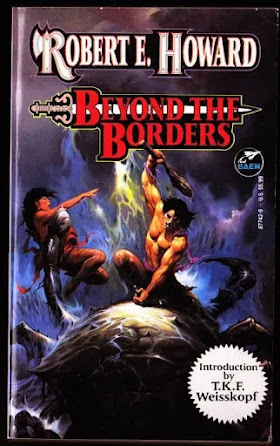I first read REH's "People of the Black Coast" back in the days when I scoured the used paperback bookstores, for collections of Howard's fiction; I really hadn't known what I was missing until I read the Baen paperback: Cthulhu: Mythos and Kindred Horrors, a book that contained "Pigeons from Hell", perhaps the most terrifying story I'd ever read. The book was called "Black Canaan," the title of another Howard horror story contained within, with a cover illustrating "Black Coast" by artist Ken Kelly. The above pic is of another illustration for the same story, also by Kelly for Beyond the Borders, part of the "Robert E. Howard Library series of books released during the nineties. Both are out of print nowadays.
The story is a bizarre one: a man and his young finance are marooned on a strange island whose beach is backed by towering basaltic cliffs. While the hero is exploring to find the extent of the cliff wall, a terrible tragedy strikes; the man returns to find the girl dead and dismembered. Sick with grief, he wanders until collapsing with exhaustion. When next he wakes, to his horror he finds himself surrounded by the young woman's killers: enormous crab-monsters, whom he senses possess a vast intelligent, perhaps beyond his own. He muses that he felt as wild beasts must feel "when first confronted by men." I surmises that killed his fiance "to satisfy some useless scientific experiment." Fearsomely armed though they are, the protagonist is able to slay them with his blugeon, finding they have evolved to be less coordinated then their smaller brethren, presumably the result of their great intellect, similar to how humans have become weaker thanks to civilized degeneration. This gives our hero the advantage, and he spends the rest of his existence hunting and exterminating the creatures. The crab-monsters do, however, possess terrifying mental powers that can stun and overwhelm an attacker, perhaps to compensate their lack of physical prowess. The narrator tells us that they are at slower ebb at dawn, and that he must "strike and kill quickly, as a lion must kill an armed hunter before the victim can aim and fire." He plans he will eventually ascend up to the demon-city high in the cliffs where he will slaughter, and finally be slain himself, as a final act of vengeance. "They slew my mate, I take their lives."
Like many other non-Conan stories, this was adapted into a Conan tale by Roy Thomas called "Man Crabs of the Black Cliffs." This issue I never particularly cared for as the art by Buscema and Chan made the creatures appear more humanoid than they are in Howard's original. The crabs of the black coast have evolved sentience without evolving a form parallel to that of humans, something likely to be true of intelligent aliens, should they exist.
But the really interesting thing about "People of the Black Coast" is that the intelligent crab scientists Howard's nearest equivalent of the Mahars, the sentient rhamphorynchoid pterosaurs of Edgar Rice Burroughs' Pellucidar stories. Possessed of cold, vast intellect, seeing humans as mere curiosities to be studied and exploited, the similarity is striking, especially their frightening mental powers that can paralyze or kill a foe. There is a hint that this is also how they communicate with one another, in the same fashion as the Mahars, with powerful currents of intellect. The hero, though, never establishes communication with them; he doesn't care to, seeking only revenge.
Robert M. Price, an authority on the works of Lin Carter, states in Lin Carter: A Look Behind His Imaginary Worlds, that "the Mahars are absent from (Zanthodon) Carter's version of Pellucidar." He does note that there is a species of giant vampiric leeches (the Sluggahs), which a dwarfish race called the Gorpaks worship as gods and offer human victims, comes the closest, but that "these lack the Mahars' malevolent intelligence. The professor character does perceive what seems to be an icy intellect burning in the eyes of one of the sluggahs, but basically the leech-monsters are just animals, feeding off their victims as any other animal might. Very unlike Howard's crab-monsters, who are motivated by scientific curiosity.
This wasn't the case with my own (mostly unsuccessful) attempt at writing a Pellucidar-like lost world novel myself The Eighth Continent. True Mahar analogues are present, in the form of giant cephalapoid mollusks, which survived the end of the dinosaur era, and evolved intelligence in the intervening millions of years. They developed a communication system based on skin colors and patterns, a vastly more advanced form of what octopoid mollusks actually possess. They may own their existence to Howard as much as Burroughs. I also tried to incorporate lost human civilizations into the mix as well, a concept that didn't really work well. It would have been better to have the "Great Lords", dominating a world in habited soley by "cave people", similar to the world of the Mahars.


No comments:
Post a Comment